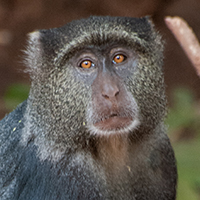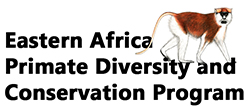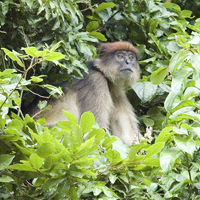Photographic Maps
Photographic Maps of the Primates, Warthogs, Dik-Diks and Hyrax of Africa: A Tool for Identification and Conservation
The design and implementation of effective conservation measures for primates, warthogs and hyraxes requires an efficient, low cost, and accessible resource for the identification of species and subspecies. Although photographs cannot replace an adequate museum collection as a resource for assessing species variation, geotagged photographs are a relatively fast, inexpensive, convenient, and unobtrusive means for detecting and assessing phenotypic variation within a species/subspecies over large areas. The use of photographs to document phenotypic characters will become increasingly important as the collection of specimens for hands-on assessments becomes ever more difficult.
Our 14 newly up-graded on-line photographic maps (or ‘PhotoMaps’; wildsolutions.nl), with over 2400 images (September 2016) of African primates, warthogs and hyraxes, together with the latest distribution maps, provide insight into each taxon’s phenotypic characters, diversity and biogeography. These ‘living’ collections of geotagged images are a practical tool for documenting and discussing diversity, taxonomy, biogeography, distribution and conservation status and, therefore, for planning actions for conservation.
Access the Photographic Map of your choice below!
-
Dwarf galagos
-
Galago
-
Small-eared greater galagos
-
Large-eared greater galago
-
Savanna monkeys
-
Patas monkey
-
Gentle monkeys
-
Baboons
-
Mangabeys
-
Guereza colobus
-
Angola colobus
-
Red colobus monkeys
-
Sykes's x vervet hybrid
-
Warthogs
-
Hyraxes
-
Dik-diks
-
Galagoides & Paragalago sp. Small galago. Nocturnal, arboreal, primate, endemic to Africa.
Click here to access the dwarf galago PhotoMap
-
Galago sp. Medium-sized galago. Nocturnal, arboreal, primate, with a wide geographical range. Supported by bushland, woodland and riverine forest.
Click here to access the small-eared greater galago PhotoMap
-
Otolemur garnettii. Relatively large galago. Nocturnal, arboreal, primate, endemic to eastern Africa. Supported by forest.
Click here to access the small-eared greater galago PhotoMap
-
Otolemur crassicaudatus. Relatively large galago. Nocturnal, arboreal, primate, endemic to the southern half of Africa. Supported by woodland, forest and thickets.
Click here to access the large-eared greater galago PhotoMap

Chlorocebus sp. Medium-sized, semi-terrestrial monkeys. Patchily distributed over its extensive geographic range in sub-Saharan Africa.
Click here to access the Savannah Monkey PhotoMap
-
Erythrocebus patas and Critically Endangered Erythrocebus baumstarki. Medium-sized, largely terrestrial monkeys. Endemic to tropical Africa. Rare in Eastern Africa, relatively abundant in western Africa.
Click here to access the Patas Monkey PhotoMap

Cercopithecus mitis. Medium-sized, arboreal group of monkeys. Endemic to Africa, south of the Sahara. Occupies all types of evergreen forest.
Click here to access the Gentle Monkey PhotoMap
-
Papio sp.. Large, adaptable, semi-terrestrial genus. Endemic to sub-saharan Africa and Arabia. Occupies all types of vegetation.
Click here to access the Mangabey PhotoMap

Mangabeys
Cercocebus sp. & Lophocebus sp. Medium-sized primates, endemic to equatorial Africa.
Click here to access the Baboon PhotoMap
-
Colobus angolensis. Medium-sized, arboreal species with highly specialized diet. Supported by equatorial Africa.
Click here to access the guereza colobus PhotoMap
-
Colobus angolensis. Medium-sized, arboreal species with highly specialized diet. Supported by equatorial Africa.
Click here to access the Angola colobus PhotoMap
-
Piliocolobus sp. Medium-sized, arboreal, group of monkeys. Supported by the forest of tropical Africa equatorial Africa with highly specialized diets.
Click here to access the Red colobus Monkey PhotoMap
-
Images obtained from two Sykes's x vervet hybrids in Kenya. See the following publication: De Jong, Y.A. & Butynski, T.M. 2010. Three Sykes’s Monkey Cercopithecus mitis × Vervet Monkey Chlorocebus pygerythrus Hybrids in Kenya. Primate Conservation (25) 43-56. Click here to access the Hybrid PhotoMap
-
Phacochoerus sp.. Medium sized suids with sparse pelage, whiskers along the lower jaw, and tusks. Two species occur throughout the wooded and open country of sub-saharan Africa, the common warthog (Phacochoerus africanus) and the poorly known desert warthog (P. aethiopicus).
Click here to access the Warthog PhotoMap
-
Order Hyraxoidae. Small mammals without visible external tail. Three genera; Dendrohyrax (tree hyrax), Heterohyrax (bush hyrax) and Procavia (rock hyrax).
Click here to access the Hyrax PhotoMap

Genus Madoqua. Small monogamous antelope adapted to arid and semi-arid bushland. Taxonomy debated. Polytypic genus with four species (two subgenera, following Kingdon 2013).
Click here to access the Dik-dik PhotoMap
PhotoMaps are useful to those who want to:
- identify species/subspecies;
- know which species/subspecies occur in which areas;
- obtain species/subspecies photographs ;
- confirm species distribution;
- describe variation within a species/subspecies, especially as it relates to geographic distribution.
If you have photographs of African primates, warthogs or hyraxes from the less documented areas of Africa (i.e., gaps on the PhotoMaps), please consider contributing them to the PhotoMaps. The photographers name is attached to each photograph. Anyone wishing to use a PhotoMap photograph must obtain both permission and the photograph from the photographer.
Send your photographs, and the coordinates and/or place name of the site where the photographs were obtained, to yvonne@wildsolutions.nl
We thank Arnoud de Jong for his technical expertise and great help with the PhotoMaps!
Publications
De Jong, Y.A. & Butynski, T.M. 2010. Photographic Maps of the Primates of Kenya and Tanzania: A Tool for Identification and Conservation. Primate Conservation 25: 27-32. Download here
De Jong, Y.A. & Butynski, T.M. 2010. Request for Photographs of the Rock Hyrax (Procavia capensis) in the Middle East. Wildlife Middle East Newsletter 4 (4): 9-10. Download here

Kolb’s monkey (Cercopithecus mitis kolbi) at Aberdares National Park, Kenya













 Angola colobus
Angola colobus

 Warthogs
Warthogs Hyraxes
Hyraxes